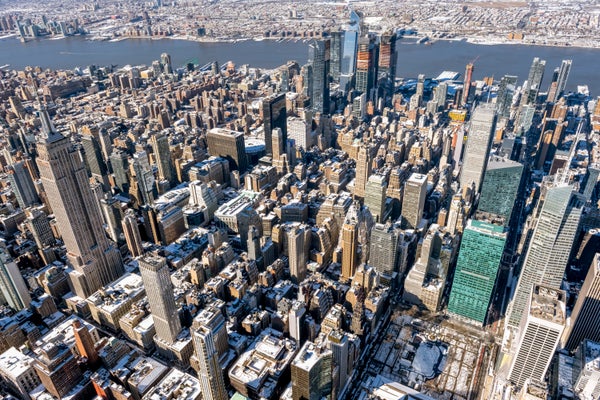Earthquake Shakes New Jersey, New York State, Pennsylvania, and More
A magnitude 4.8 earthquake struck near Lebanon, N.J., at 10:23 A.M. EDT. Shaking was felt over a broad area, including parts of New York State, Pennsylvania and Connecticut

An aerial view of Hudson Yards, the winter village at Bryant Park, the Empire State Building and Madison Square Garden in New York City on February 4, 2021.
C. Taylor Crothers/Getty Images
Editor’s Note: This story will be updated as more information becomes available.
A magnitude 4.8 earthquake struck near Lebanon, N.J., at 10:23 A.M. EDT. Shaking was felt over a broad area, including New York City and other parts of New York State, as well as regions of Pennsylvania and Connecticut.
According to initial U.S. Geological Survey data, the earthquake occurred a depth of nearly five kilometers, which is relatively shallow. Shallower earthquakes tend to produce more shaking at the surface for a given magnitude. Damage and injuries from this one are likely to be minimal given its magnitude, the USGS projects.
On supporting science journalism
If you’re enjoying this article, consider supporting our award-winning journalism by subscribing. By purchasing a subscription you are helping to ensure the future of impactful stories about the discoveries and ideas shaping our world today.
The event echoed a magnitude 5.8 earthquake near the town of Mineral, Va., on August 23, 2011. That quake was the strongest to strike the eastern U.S. since 1897, according to the USGS. It caused property damage in the range of $200 million to $300 million.
According to the USGS, an earthquake of the magnitude of today’s has not struck this close to New York City since 1884.
Earthquakes are not uncommon in the eastern U.S., but they typically do not reach the intense magnitudes that faults in the western parts of the country can generate. Even ones of the relatively moderate strength of Friday’s quake “are unusual, but they do occasionally happen,” says Benjamin Fernando, a seismologist at Johns Hopkins University. “It’s a pretty quiet part of the country.”
Just as they do all over the planet, faults crisscross the northeastern U.S. Many of these faults are extremely old and are associated with the building of the Blue Ridge and Appalachian Mountains hundreds of millions of years ago, Fernando says. Others are newer, by geological standards, and linked to the opening of the Atlantic Ocean.
There are some early suggestions that this earthquake was caused by a rupture of the Ramapo border fault system, an old fault that runs from Pennsylvania through northern New Jersey and into southeastern New York State. It was formed by the collision that created the Taconic Range (part of the Appalachians) around 440 million years ago and reactivated during rifting that was caused by the breakup of the supercontinent Pangaea, according to Kenneth Miller, a Rutgers University–New Brunswick geologist. “This fault regularly experiences earthquakes but they are generally an order of magnitude smaller than today’s,” Miller wrote in a statement that was shared with Scientific American. (The earthquake scale is logarithmic, so a magnitude 3.0 quake is 10 times smaller than a magnitude 4.0 one and has 32 times less energy.) “This appears to be the largest earthquake on the fault since 1957,” Miller added.
The fault is generally subjected to stresses that have arisen from the crust in the Northeast rebounding after the retreat of the ice sheets that followed the last ice age, as well as to continuing reactions to the aforementioned mountain building that occurred long ago, Fernando says. But it will take a detailed analysis to determine the exact point and mechanism of fault rupture, he adds.
Earthquakes are felt over a larger area in the eastern U.S. compared with the western area of the country because the former has very hard bedrock that transfers seismic energy more readily. In the western U.S., Earth’s crust has more faults and other deformities, which tend to dissipate that energy quickly. The 2011 earthquake was felt from Florida to southeastern Canada to Wisconsin. As much as one-third of the U.S. population may have felt shaking from it.
Aftershocks will occur from the earthquake, and seismologists urge people to be aware. But aftershocks are generally at least a magnitude lower than the initial earthquake and become progressively weaker over time, so “it’s possible that you wouldn’t get anything that you would notice,” Fernando says.
If you felt the earthquake, you can contribute to community science and report your experience to the USGS here. Fernando hopes this earthquake will help bolster research into the fault systems in this part of the country to better understand the risks they pose.
This earthquake is not related to the magnitude 7.4 quake that struck Taiwan earlier this week. Earthquakes happen across the planet every day. People have also long studied any potential links between solar eclipses and earthquakes, but “as far as I know, there’s no correlation there,” Fernando says.
Additional reporting by Meghan Bartels.

